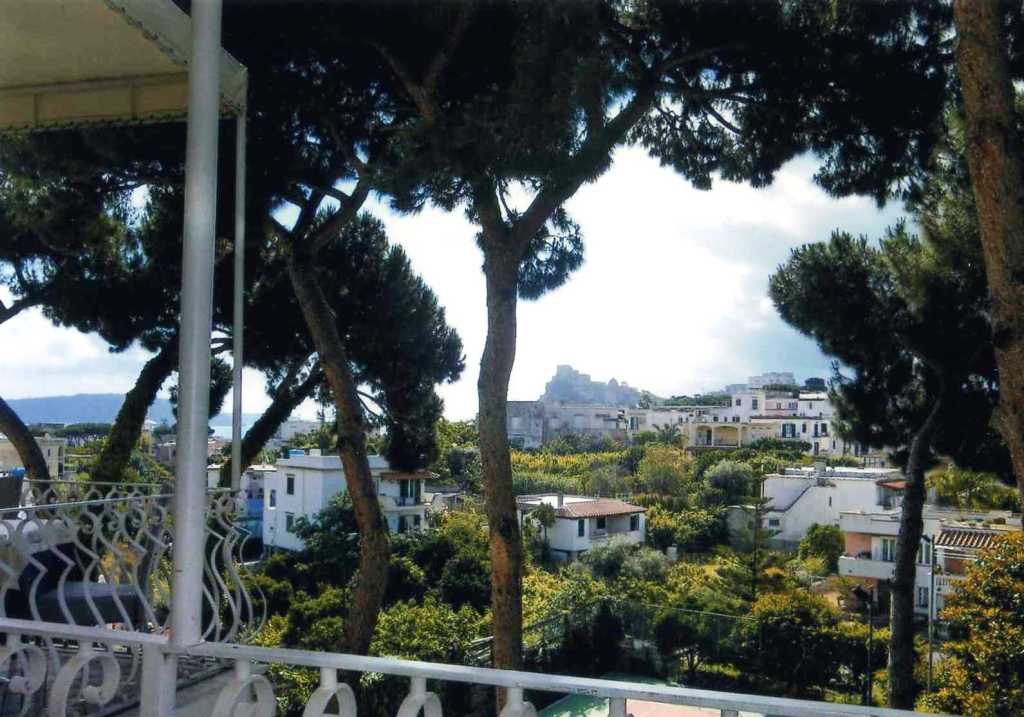
GO TO NAPLES!
By: Tom Frascella July 2014
In the early 1850’s southern Italy, or as it was known then, the Kingdom of the Two Sicilies was fractured by internal political strife. The repercussions of the Carbonari revolt of 1848 carried over in the form of political suppression the 1850’s. As we previously discussed, the Carbonari movement got its name and start in southern Italy in the late 1700’s. Masonic based secret societies became established in every town and village in the Kingdom. By the 1830’s the movement fueled by the writings and encouragement of its northern Italian unofficial head Guiseppe Mazzini had spread internationally throughout Europe. In 1848 Europe saw Carbonari inspired revolts in more than a half dozen countries and throughout the various regional Italian States. While the Carbonari revolts in northern and central Italy had some measure of initial success between 1848 and 1851 the story of revolt in the Kingdom of the Two Sicilies was quite different.
The Carbonari on the island of Sicily
and on the southern Italian mainland both revolted in 1848 in a coordinated if
independent act of insurgence. In Sicily, the Carbonari had some military
success against the 5,000 man Bourbon garrison on the island. Success however
was short lived as the garrison was reinforced with an additional 7,000-10,000
Bourbon troops from Naples. The Carbonari movement was not a “populist”
movement. Carbonari drew from mostly the upper and middle classes of the
population. Therefore, militarily they could be overwhelmed by sufficient
manpower if such a force was assembled against them.
On the southern Italian mainland the Carbonari were much more spread out and
ideologically diverse then their Sicilian brothers. In an attempt to coordinate
and unify the regionally diverse elements of the southern Italian Carbonari,
Giuseppe Mazzini in exile in England, had arranged for a small force of officers
and men trained in the north of Italy to secretly land near Naples. However,
when they arrived they were met and defeated by a large force of Bourbon troops.
Those northern Carbonari who were not killed on the beach were taken prisoner
and executed.
It became obvious to the Carbonari in southern Italy that they had been betrayed and that their secret plans of revolt had been delivered to the Bourbon authorities. With the crushing defeat of the landing force paranoia set in among the southern Italian mainland Carbonari. They assumed that their plans for a secret landing and organized revolt could only have been divulged by spies among them. The result of this was that the many “cells” of the mainland southern Carbonari went deep underground to avoid arrest, execution or imprisonment. Thus the Bourbon troops could act freely on the southern mainland without organized resistance and dish out reprisals as they saw fit.
What the Carbonari did not know at the time was that the organization’s communications had been compromised in England by British intelligence. Agents of the British government had been intercepting Mazzini’s communications to his fellow coconspirators in Italy. It was the British that conveyed the content and plans of the Carbonari landing to the Bourbon regime. British foreign policy in 1848 hoped to gain favored trade concessions from the Bourbon regime especially concessions involving greater access to sulfur production by betraying the plot and proving their value to the Bourbon regime.
The actions of the British not only did not accomplish their intended goals but actually accomplished quite the opposite. The near successful revolt showed the Bourbon regime its vulnerability. The Bourbon solution was to increase production of sulfur and seek new markets generating higher prices and greater State profits. Toward that end it looked to the emerging power of Russia. The Bourbon regime rationalized that with greater income they could build up their own military through conscription. They further reasoned that internally they could use the military to purge any rebellious future threat. Comfortable with their military position the Bourbons initiated between 1848 and 1856 a reign of unprecedented political suppression directed against suspected Carbonari in the south.
As the Carbonari revolts collapsed throughout Italy by 1851 thousand s of Carbonari throughout Italy found they were wanted men. Thousands were killed, many others went into local hiding and some were able to flee to foreign countries, including the United States to live in exile. Although this was also true in southern Italy, the suppression carried out by Bourbon troops was on a larger and more crushing scale than the rest of Italy.
Historically, the Bourbon reprisals of 1848-1856 disproportionately impacted the rural or provincial citizens suspected of being Carbonari. The Bourbons entrenched in their Capitol of Naples were careful to encourage the loyalty of the Neapolitan citizens. Naples was the largest of their cities and a loyal population was essential to their security. The outlying areas however did not enjoy the same Bourbon largesse. In rural Lucania, a poor and rugged State, most Carbonari rebels did not have the financial ability to seek foreign refuge. This left them with two prospects potential arrest if discovered or flight into the local mountains.
The sparsely populated hills and mountains of Lucania had traditionally served as a refuge for people who found themselves outside the law since ancient Roman times. Prior to the 1848 revolt the Luncanian population amounted to about 450,000. Crime was primarily of a common sort not political. The number of individuals in hiding from the law totaled somewhere between 100 and 200 men. Most of these men were wanted for various crimes against local authority and therefore were criminals in the traditional sense. While it is true that these men may have been driven to crime by the corruption and social inequalities of their society they are generally not considered “Political”. As an example the best known of these Lucanian outlaws was a fellow named Carmine Crocco. Carmine was an individual who had been born into a peasant rural family in Lucania and conscripted into Bourbon service in 1848. While in service he got into a fight with a fellow soldier and killed him causing Carmine to take to the familiar hills of Basilicata. While there he got word that the son of a rich local landowner from his village had dishonored his sister. That led to another fight in which he killed that fellow as well. Like the outlaws of the American West part of the reason these outlaws survived was that it was often more trouble or required more manpower to track them down than local authorities had.
Once the Bourbons began their political suppression of the Carbonari in Lucania the acts of their soldiers forced many more men into hiding. This resulted in the number of “outlaws” or in Italian “briganti” to double in the Lucanian Mountains. Put another way the number blossomed to about 200-400 in hiding. While this number would appear to still be very small the “new” outlaws clearly introduced an element of true “politics” into the equation. Suddenly the hills offered refuge to a better educated politically astute and determined criminal force.
However for hundreds of men in the south who did not flee and had not been discovered, life became more secretive. They lived in constant fear that they would be accused of anti-government activities and would be arrested and sent to political prisons without trial. The Bourbons set up dozens of special political prisons between 1823 and 1856. Most of these prisons had been ancient fortresses scattered across the landscape of southern Italy and Sicily. However, those men accused of conspiracy who were from the provinces surrounding Naples generally were not sent to prisons in the provinces. Instead because of the perceived heightened proximate threat to the crown they were often sent to prisons in and around Naples where they could be more closely guarded. Because of Lucania’s proximity to Naples many Lucanian Carbonari were sent to prison there.
These political prisons which existed in poorly retro fitted ancient fortresses were not designed to hold many prisoners, most were set up to hold 50-300 individuals. At the height of the suppression however they frequently held twice that number. A half dozen or so such prisons were located in old defensive fortresses on islands in the bay of Naples. These prisons were like mini Alcatrazes except by comparison Alcatraz was a four star hotel. Three of these “bay” island prisons are well known and were originally constructed as defensive fortresses between the 14th and 16th century. By the 19th century some of the structures were already five hundred years old. From1848 and 1856 hundreds of men from the provinces were sent to these prisons. The facilities offered the prisoners a living hell. If you were lucky you were executed shortly after arrival. If you were not lucky you were tortured, and kept in cold, damp poorly lit crowded cells with no heat sanitation or running water. There you would be sustained by meager rations until disease or despair overcame you.
Of the three best known island prisons the most infamous, made so by the writings of the British politician Lord Gladstone, was on the islet of Nisida. Nisida is located just north of the City of Naples and is connected to the mainland by a short bridge. This island prison would figure in the coming political climate of the times.
Of the other two the largest prison of the three was located on the island of Procida and the oldest of the prisons was located on the island of Ischia. Procida and Ischia are companion islands proximate to the island of Capri. Both are located about 18 miles out in the bay. Today these islands are beautiful and offer landscape vistas that rival Capri. Ischia has for decades been a favorite vacation spot for tourists especially from Switzerland, Austria and Germany who go there for the mineral rich hot baths and spas located in almost every hotel on this volcanic island. However, even today the shadow of the old fortresses on the islands is conspicuous.
I recently had an opportunity to visit Ischia and can attest to the island’s natural beauty. For the reader unfamiliar with the island I thought I would include some photographs which offer more than words in describing the location.

View from Hotel Romano toward the mountain top castle that was the prison
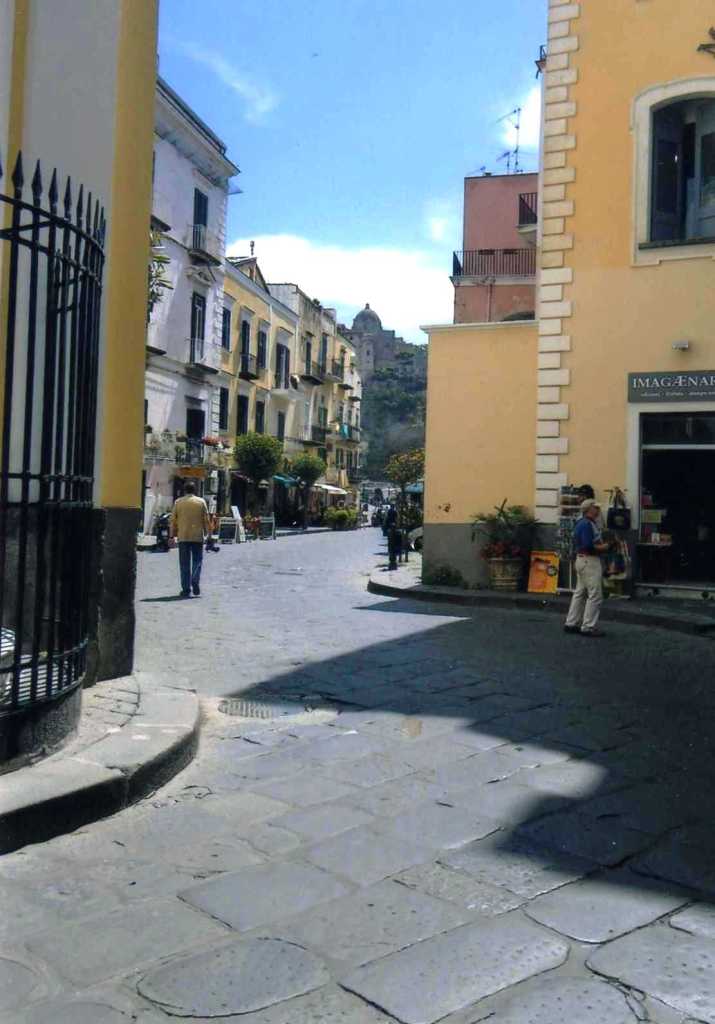
View of the town street with fortress/prison in the background
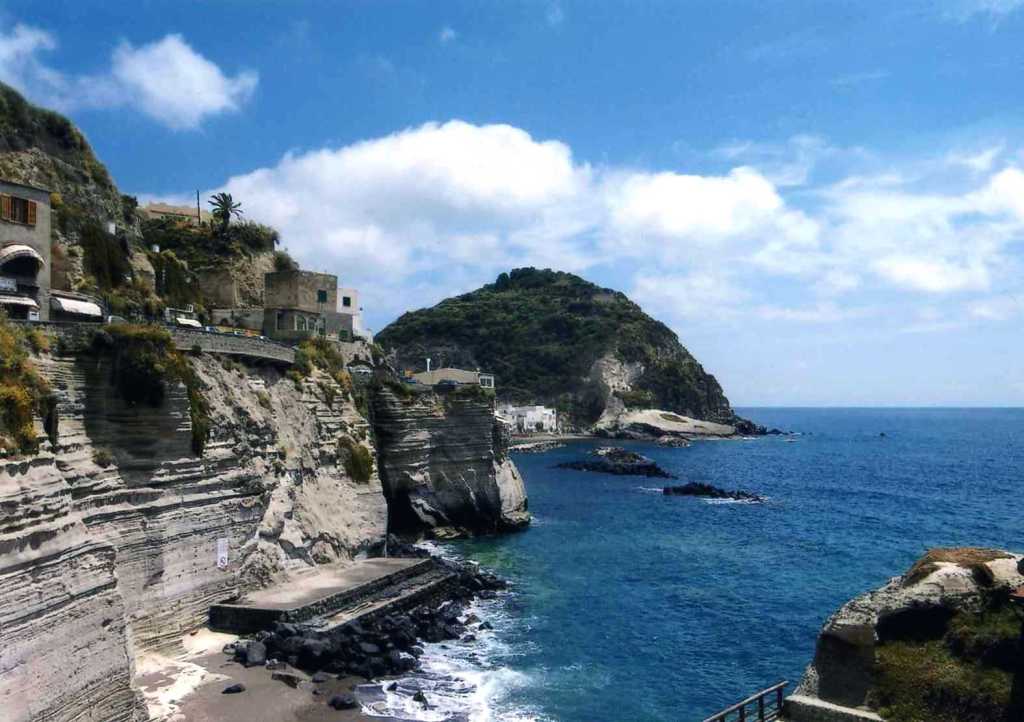
View of part of Ischia’s coast line
The castle/prison ruins are now part garden terraces, part museum, and part viewing platform. For 10 Euros you can visit taking the elevator to the top.
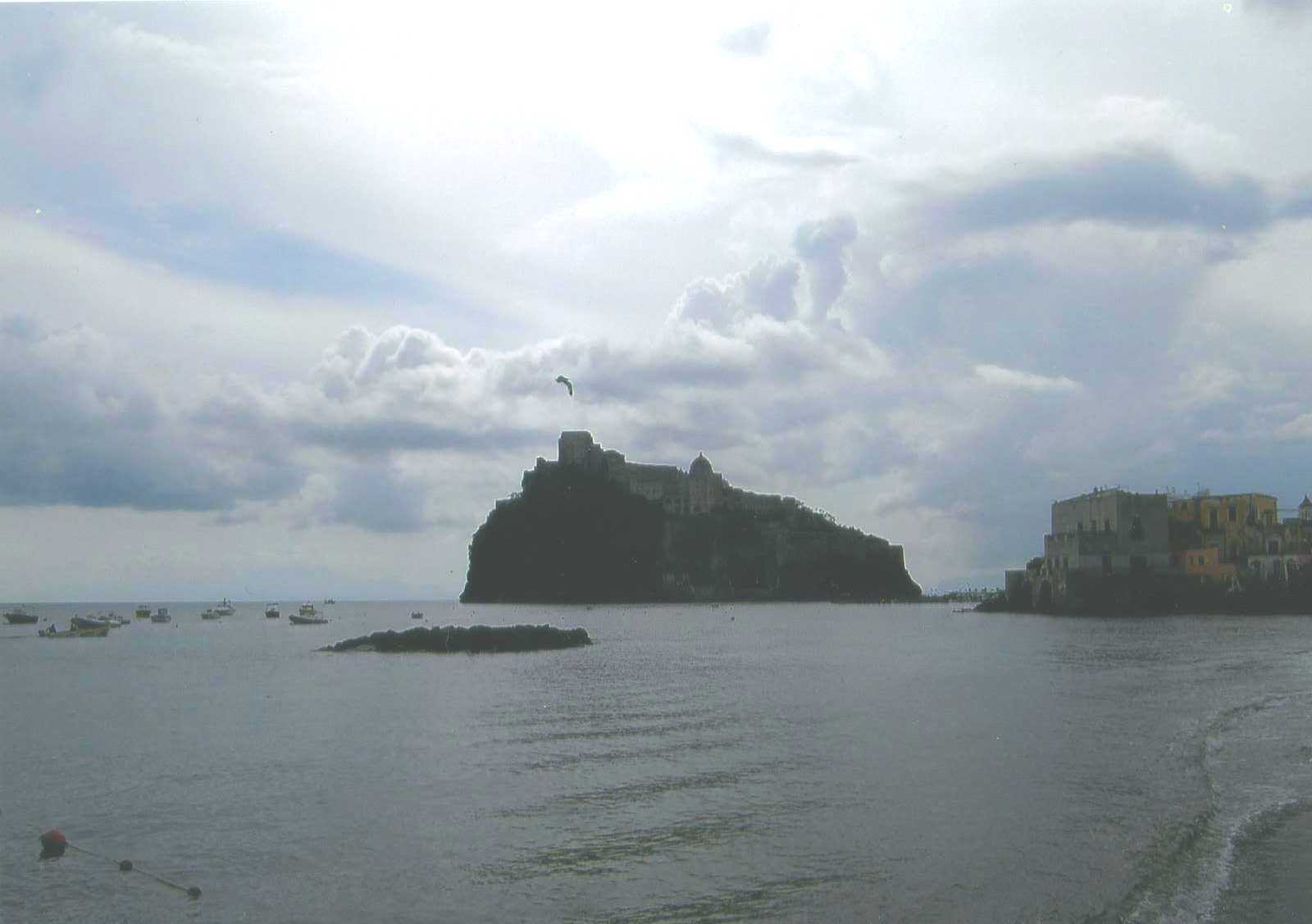
View of fortress as it appears from a distance
In one of the rooms in the upper fortress is a plaque with about seventy names on it of prisoners who died in the prison between 1848 and 1856. The Ischia prison probably held only about 200-300 prisoners so the death rate was quite high. The plaque gives their names and place of birth and essentially all of the deceased come from the Provinces around Naples. The plaque describes them as heroes who died in prison in the cause of Liberty. Sadly, this story of the sacrifices of these individuals has seldom if ever been told in Italy. In an odd way the plaque itself bears interesting testimony to the shameful intentional disrespect that these heroes have suffered in the telling of “traditional” Italian history. There at the bottom of the memorial plaque is the recitation that the plaque was dedicated in 1997. That is 140 years after their sacrifice. I would say that this commendation although more than deserved was very late in the acknowledgement.
The obvious question was why it took the various governments of Italy in that intervening century and a half so long to recognize these men who died in the cause of freedom and liberty. In part the answer lies with the fact that the part that southern Italians played in the initial thrust for civil rights and freedom in Italy has been intentionally down played by official propaganda. This allowed successive governments to continue the political imprisonments of southern Italians in these same facilities. Some of these same prisons continued to receive political prisoners all the way through World War Two. So in part an earlier acknowledgement of the heroics of the martyrs of liberty would draw attention to the continued abuses of successive governments. In fact later governments were guilty of even greater assaults on the liberties of the southern Italian people. No plaques for these later victims are present even to this day. Few if any formal acknowledgements of the brutality and abuse of power inflicted on southern Italians by post Bourbon governments have been officially or adequately made to this day.
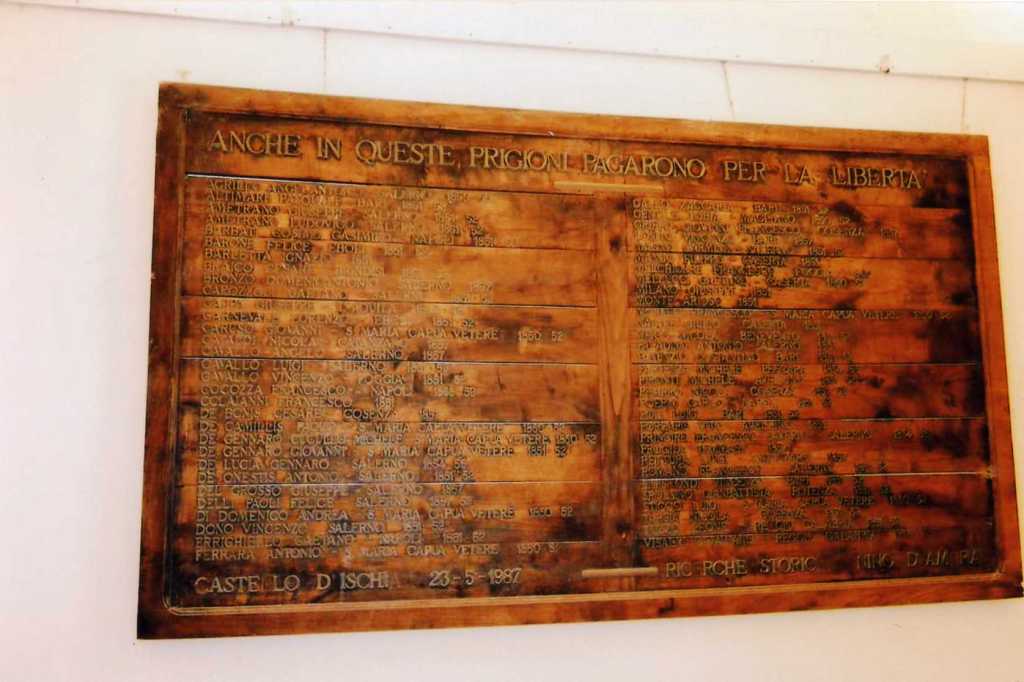
Plaque commemorating those Carbonari that died in prison at Ischia 1848-1856
Our original Lucanian ancestors arrived in the United States in the 1850’s, 1860’s and 1870’s. Upon arrival they were classified by the U.S. as “political” refugees. The U.S. government understood that many of the men arriving in the U.S. had strong republican leanings and had been persecuted in Italy for their political beliefs. For those arriving in this period the U.S. offered a welcomed sanctuary. These early émigrés understood that the political realities in Italy could have resulted in many of them being imprisoned or killed if they remained in their homeland. For southern Italians the political suppression that began in the 1790’s with the Bourbons did not end with the Bourbon defeat in1861. For them the threat of personal harm or family injury after “Risorgimento” was worse than it had been before. A continuing tide of ever worsening political suppression eventually was met with an ever increasing tide of immigration. The prisons, executions and torture of southern Italians after Risorgimento in the view of many took on the color and feel of an act of genocide. The “Unified” Italian government post 1861 engaged in an assault on the people of southern Italy and Sicily which was unprecedented in the actions of any government against its own people in 19th century European history. A fact well known by Italian authorities who hid their actions rather than risk universal condemnation. Instead the government portrayed the victims as criminals and their abuse and inhumanity as virtuous national heroics.
This brings me to the selection of the title of this article. There was an expression which was common among certain early southern Italians who were part of this “political refugee” segment of Italian immigration. The expression translated into English literally as “Go to Naples”. To those not familiar with the 19th century political state of the region it is possible to misunderstand the expression. After all 19th century Naples benefited from the building programs of the Bourbons which I have described in other articles. As a result the city was on everyone’s “must see list” for their European Grand Tour. Naples as a city was a jewel among Italian capitols. In addition to the grand palaces, the stunning beauty of the coast line and islands is to this day breathtaking. I should not leave out that the people of Naples enjoy life, music and food with the enthusiasm that rivals any city in Italy. So the expression “Go to Naples” or in Italian “va fa Napoli” would seem to be an invitation meant to express warmth and well being. However, this would be a view out of the context of life experiences of our 19th century immigrating ancestors. As expressed by them it was in fact an invective, a curse. In their experience when they went to or were sent to Naples it was to prison not a five star hotel. In the southern Italian dialect the expression of our ancestors was pronounced “va fa Na beh la” or more often the clipped version “fa na beh la”.
Later Italian governments have kept their repressions out of public view and so today the expression “Go to Naples” is pretty much unknown. This has led some modern language historians to speculate that the expression is not of Italian but rather Italian-American origin. Italian-Americans familiar with the expression generally say the expression means “Go to Hell”. Interestingly, even most descendants of these early southern Italian immigrants know the original context of the expression. Actually the expressions means “go rot in prison” where prison for our ancestors’ was located in Naples. In common usage this curse was reserved for people that were making you angry or very frustrated and therefore you were wishing evil in the form of imprisonment, torture and death.
So the title of the article represents a small chapter in dialect “language history” which in effect records a time and circumstances many Italian officials over the decades have actively tried to cover up or deny. In their defense I will say that some modern Italian historians are beginning to acknowledge and rewrite Italian history to more accurately reflect what actually took place. They have a long way to go.
The 1848 aborted uprising did lay the foundation for the events and successful uprising of 1860. However the tragic turn of events thereafter set the stage for the mass migration of Lucanians to the U.S from 1850-1880. So discussing the political actions and impact of the various Italian governments of this time is a logical starting point for our Lucanian-American story.
The Lucanian immigration story in central New Jersey begins with the arrival in Trenton of Vito Frascella in the spring of 1862. He was twenty-two years old when he arrived as he was born in San Fele in 1840. He was only eight when the 1848 Carbonari revolt in Italy occurred. The toxic political suppression of the Carbonari by the Bourbons between 1848 and 1856 occurred during Vito’s formative teenage years. It is difficult to say exactly what effect the repressions of the period had on Vito as no writings which he authored regarding his experiences during that time exist. However, some oral family history does shed some light on his take on the times. Vito lived to be almost eighty and most of his grandchildren had adult memories of him which they passed down at family gatherings. It was clear from what they said of him that he brought the memories of his youthful Italian experience with him to America. Family members would recall that he was a strong advocate of active and participatory democracy. As an American he was a proud Republican Party member. My grandparents’ generation would explain to me that he insisted his children and grandchildren should also be members of the Party of Lincoln. He viewed the American Civil War as a testament of sacrifice to the sentiments that Lincoln espoused. He also believed that the Italian monarchy and cabinet lacked the moral authority to rule. He told children that he brought his family to America because he wanted to raise his family under those democratic principles. He regarded Italian politicians’ corrupt, lying and deceitful individuals whose words could not be trusted. He apparently had very strong feelings on the subject and would object to the Italian flag being displayed at American celebrations in the community. I got the impression that his response to the Italian Flag was “fa Na bleh la. If his reaction and that of the hundreds of San Felese and thousands of other Lucanians who immigrated during that period seems a bit strong I don’t think it will as the story of their immigration unfolds.
© San Felese Society of New Jersey